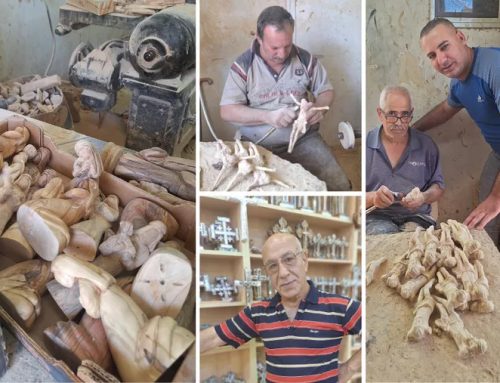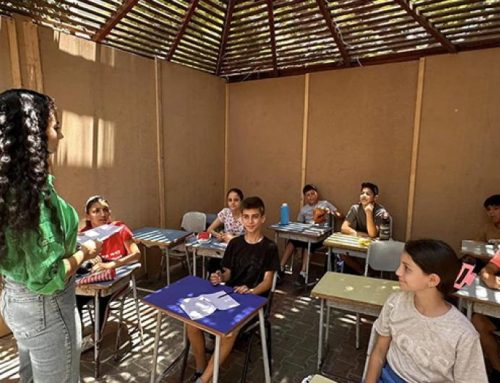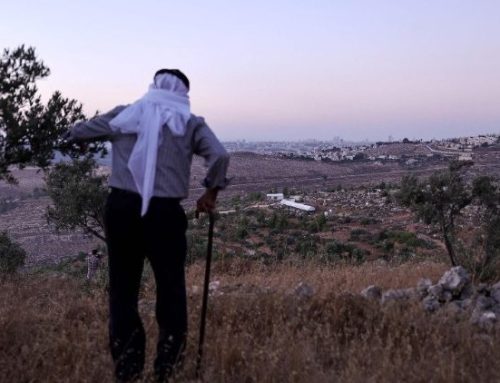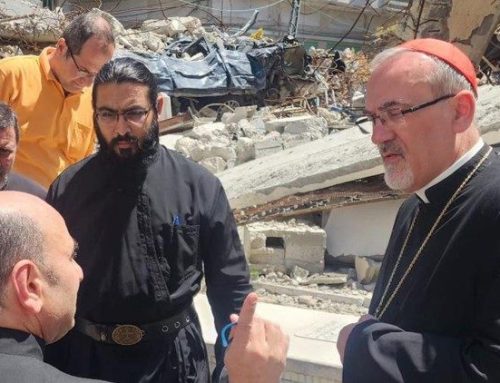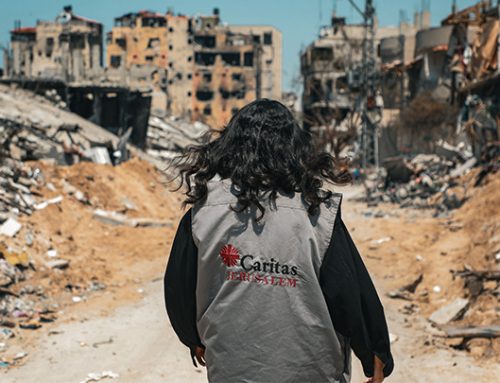The entrance to the West Bank is at an opening on the Israeli security fence on what I’m told was one of the main roads between Jerusalem’s Old City and Bethlehem. The entrance to the West Bank is at an opening on the Israeli security fence on what I’m told was one of the main roads between Jerusalem’s Old City and Bethlehem. Bethlehem is something of a suburb of Jerusalem, although that definition doesn’t quite fit. The distance as the crow flies from our hotel, just outside the Old City, to the checkpoint between Israel and the Palestinian-controlled West Bank city of Bethlehem is only about 15 minutes when traffic is light. The checkpoint was strangely nondescript in one sense: there was no discernible buffer zone or “no man’s land” between the Jerusalem neighborhood and the opening in the wall. We simply made a slight jog in the road, and there looming ahead was the massive concrete barrier, snaking away from the checkpoint in an outwardly-moving “V” from the entrance, a parking lot that was situated between Israeli soldiers and members of the Palestinian Authority security force. This was where our “exchange” would take place. We arrived about five minutes early, and we had a chance to look around. A couple of us took out our cameras to take photos: there was a tunnel made of fencing that Palestinians wanting to gain access to Jerusalem to work had to pass through. We couldn’t see the area where Israeli police would interview people crossing the border, but I spied a woman at the gate who’d already gone through the security check and was being grilled by a soldier at the gate. A glance to our guide and driver provided no information, so I figured she was getting the once-over one more time before heading to town. Soldiers manning the tower looked at the activities below. You knew there was someone who could bring a weapon to bear at the ready, if they weren’t already. Because we were guests of the Israel Ministry of Tourism, and since we already had made contacts with our friends at the Holy Land Christian Ecumenical Foundation, we were waved through, a strange and surreal process when we considered that everyone else passing through would be screened and then questioned for up to an hour or more. We zig-zagged through the narrow streets of Beit Jala, a huge neighborhood that is part of Bethlehem, the holy city where Christ was born. Our small contingent of Catholic journalists from across the United States, sponsored by the Catholic Press Association, had finally made it to one of the most important legs of our journey, during which we would meet with representatives of the Latin Patriarchate of Israel – the diocesan structure that supports the church in the Holy Land. We had learned earlier during this visit to Israel that although our itinerary included an “optional visit to Bethlehem,” due to constraints placed on travel for citizens of the Jewish state, our guide was not allowed to take us into the holy city, which lies inside territory that is controlled by the Palestinian Authority. They would take us to the checkpoint, but we had to make our own way to and through the city once we’d cleared the barrier and checkpoint. There was no animosity to or from our guide about this; she was simply obeying her country’s law. We would have six hours to see all we could see of Palestine’s West Bank. So, as I had planned all along, I contacted the Holy Land Christian Ecumenical Foundation, and they assisted us when as entered the West Bank. HCEF had developed an important twinning relationship with St. Andrew/St. Elizabeth Ann Seton Parish in Milford, and thanks to some assistance from Father Rob Waller, St. Andrew’s pastor, our entourage was able to clear the barrier into the West Bank without too much of a hitch. One of the most visible parts of the West Bank, Bethlehem is under the control of the Palestinian Authority, and therefore is territory that the government of Israel has partitioned off with high concrete walls capped with circular strings of concertina wire. The controversial wall, reminiscent of the divide between East and West Germany during the Cold War, had been constructed to protect Israeli citizens from suicide bombings during the height of the Intifada, a Palestinian-Israeli conflict that had raged beginning around 2001. But the effect on the people within those walls has been devastating, if effective against the tide of suicide bombings. The HCEF staffers made a particular point of showing us an apartment that they said was one of the only buildings situated up close to the new wall – the wall is about three years old, they told us. My mind’s eye didn’t prepare me for the sight, though. We emerged from one of the main streets onto a side road that led downhill to a neighborhood that had been pretty much eradicated when the wall was put into position. The wall itself is made of connecting slabs of concrete that look to be maybe five feet wide and about 50 feet high. Interspersed at critical junctions along the wall, the Israelis have constructed round watch towers like you see on prison walls, an appropriate comparison, since the Palestinian Christians we talked to today say that life in Bethlehem and Beit Jala is like living in a prison. I was instantly reminded of the watch towers that used to hover over the old East-German border. In my Army days, I used to patrol that border, escorted by the West German border police, known as the Grenzpolezei. As I got out of the van, I peered up to the watch tower that overlooked the apartment, wondering how many soldiers were watching us, if they were photographing us, if they were aiming at us. The apartment building was a shock to see. Surrounded on three sides by the wall, it appeared to be an aberration in the planning on the wall’s route, the concrete divider here bowing out like an inverted omega symbol with the building set in its middle. The HCEF folks had called one of the apartment-dwellers in advance, and so we already were expected. We weren’t going to sit for coffee, which is the Arab way (these were all Arab Christians we were visiting. In fact, Bethlehem’s population is about 40 percent Christian). Instead, we were going to say hello, look around and then depart. There was some concern that if we stayed too long we would cause suspicion and alert an army patrol which might then come to the apartment. We didn’t want to cause these people any difficulties. So we went up four flights of steps to one of two apartments, where we were greeted by a grandmother and her three grandsons. It was a beautiful apartment inside, but when you peered out the windows or stepped out onto their terrace, the view was not of this world. Everywhere we looked, the wall loomed even higher than the building, the concertina wire a menacing metal kudzu that grows wild in these parts. I spied a security camera, so I moved to another part of the building to get a view. After only a few moments, we shook hands and walked back down the steps. “Would you like to walk around the building?” our HCEF host asked. We agreed to check it out. We explored the DMZ that was actually quite narrow, graffiti festooning the walls with messages that seemed benign and out of place, such as “Jesus Loves You,” among others. This was an uneasy moment, so we didn’t linger, but as I walked towards the van to leave, I looked back up at the watch tower that was placed to monitor this sector of the wall. I could just make out a couple Israeli soldiers peering down at me through binoculars. It was an eerie, scary feeling; one that the Palestinian Christians we met throughout the day experienced as a daily routine of their lives. A quick history lesson We drove on winding, hilltop roads through Bethlehem, and soon our Palestinian guide, Rimzy, pointed out that we were in Beit Jala; I wouldn’t have known the difference. Everything blended together, and we still were very close to Jerusalem. We pulled into a narrow driveway where there was a squat, one-story concrete block building. Behind that building there was a schoolyard, and we had arrived just in time to hear children playing and running around. Turns out these were kindergartners in a program that had just recently been launched. We didn’t see them, but we could hear them: To me it sounded like the voices of blissful joy, of little children who probably don’t fully appreciate the situation into which they’ve been born. We met Father Majdi al Siryani, a citizen of Jordan who had spent several years in Dearborn, Mich. He looked to be in his mid-to-late 40s, exuding a kind of forceful energy gained from working out. Father Majdi is a Christian Arab, one of the 30,000 or so Christians living in the Bethlehem region, where Christians make up perhaps 40 percent of the overall population. Bethlehem, Beit Jala and Beit Sahour make up three townships nearby where there was a concentration of Christians. Christians in the West Bank also live in Ramala and Nablus; and, of course, Nazareth is the largest Christian city in Israel. It all seems very strange that in the land where Jesus ministered, died and raised up from the dead that His followers are a tiny minority today. We’re told overall that Christians make up less than 3 percent of the population here. So it is critical for the church to insure that the diaspora of Christians doesn’t worsen. The work of Father Majdi, the HCEF and every other Church-related initiative here remain critically important for that mission “We are a tiny minority here,” Father Majdi said. “But this is a terribly important Christian community.” When you look at the region from the outside, “every nation recognizes and understands the importance of the Arab presence here,” and the Christian Arab community has been in the region since the time of Jesus. “Arabs are not aliens,” he said. “We’ve been here for thousands of years.” Father Majdi explained that from the beginning of the papacy of Pope Pius IX, there has been a ministry to Christian children in the Holy Land, and from that era, the Latin Patriarchate for Schools emerged. The idea, quite simply, is to insure wherever there is a parish in the patriarchate, there also is a school. “It’s the place for a good education, but it’s also how we catechize the kids,” he said. He had spent some time as a parish priest in Los Angeles, and he noted that the parish-school package here was the same you’ll find in the States. The exception is that these schools receive virtually all their funding from outside sources, much (perhaps the lion’s share) from the United States. The differences lie in the importance the church plays in the lives of these Arab Christians. “Essentially, the parish takes care of those things in life that the government doesn’t,” and with the limitations of the Palestinian Authority to do much, that means that often health care, education, housing for the elderly and the other functions that you might expect the state to provide are addressed by the church. “The extended family, the tribe, also takes care of the people,” he said. So there is the family, the tribe and the church all at work in this supporting role. And it leads to a mutually supporting atmosphere that he said is not visible to people on the outside. In fact, sometimes people believe there are conflicts galore. “Because Bethlehem is Christian and the surrounding communities are Muslim, there is a perception that there are conflicts between us. But that is not true. We all get along.” Father Majdi was filling us in on the particulars of the difficulties of living in the West Bank when he related a remarkable and sad, sad story. He held up a card that was about the size of a driver’s license and told us that very few Palestinians have access to it. It is a “Jerusalem” card, granting the holder permission to enter the holy city of Jerusalem. “The thing to understand is this,” he said. “Jerusalem is like our downtown here” for people from Bethlehem, Beit Jala and surrounding communities. “This is our city, too. But if you are Palestinian, once you turn 16, you no longer can just enter the city. You have to have one of these cards to get in.” And it is rare, indeed, to get such a card. Father Majdi nods his head over to the two young staffers from the Holy Land Christian Ecumenical Foundation, observing that neither of them had been to the Old City. Schoolchildren from all over the Patriarchate joined their parents, friends and teachers for a day of prayer, where they walked through the Old City, praying the Stations of the Cross. “This was to be a very reverential day, and the kids were very good,” Father Majdi said. “But, sadly, many of the adults who were to come along weren’t allowed permission to come along” by the Israelis. “One entire school had to cancel the trip, because all the adults scheduled to go were denied access.” Still, it was a day of hope for the children and families who were able to participate. I think of it not as an act of defiance, per se, but more like a demonstration of faith and strength of the kind we aren’t all that familiar with in the States.

